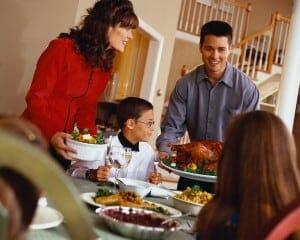 Invite guests, asking everyone to RSVP before the event so you know how much
Invite guests, asking everyone to RSVP before the event so you know how much
- Find out if your guests have special dietary requirements.
- Make sure you have enough tables, chairs, glassware and dinnerware or make arrangements to borrow or purchase
- Decide on the menu and collect all recipes. To avoid an overloaded oven or range top, select a few recipes that serve
- well at room temperature. Calculate the cooking time and temperatures (plus cooking order) for your menu.
- Prepare three shopping lists: one for food prep safety items, one for perishable food and one for non-perishables.
- Check the tools and ingredients you have on-hand. Verify that dried herbs and spices are not expired.
- Plan decorations that are suitable for your setting.
- Check to make sure your food thermometer is in working order and calibrated.
- Check your inventory for platters (one for raw meat, one for serving). Clean the platters and other serving dishes and
- Hardy vegetables such as onions, carrots and potatoes can be purchased one week ahead, while, salad greens and
- perishable vegetables should not be purchased until the day before.
- Enlist the kids to help with baking, or have the kids make leftovers labels.
- When setting the table, be sure to remember the salt and pepper shakers, butter plate and all the serving utensils.
- Wash, trim and cut fresh vegetables on a clean cutting board. Wash leafy greens, spin, dry, and store by packing in
- paper towels in a sealable plastic bag in the refrigerator for no longer than one day.
- Set up the beverage bar with glasses, napkins and bottle/wine opener.
- Make sure you have room in your refrigerator for all the food, so if you don’t have enough space, chill the beverages in
- On the day of your event, prepare the cleaned vegetables for cooking – peel and chop using clean utensils and a clean
- cutting board. Cover the ready-to-cook vegetables and put them in the refrigerator. Remove cold desserts from the
- refrigerator to allow them to come to room temperature.
- Use a food thermometer to check the internal temperature of meat.
- After your event, divide all leftovers into smaller portions and store in shallow containers in the refrigerator within two
- hours. Let your kids use their leftover labels to mark a “use by” date on the containers.
- The non-profit Partnership for Food Safety Education saves lives and improves public health through research-based, actionable consumer food safety initiatives that reduce foodborne illness. Sign up to be a BAC Fighter!